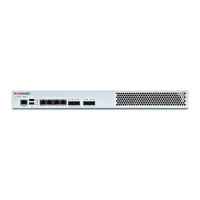Configuring Network Interface (Network Setting) How to set up your FortiWAN
Back to System > Network Setting > DNS Server, it enables administrators to define the host name the FortiWAN
in the network, the IPv4/IPv6 address of domain name servers used by FortiWAN, and the suffix of the domain name.
The following is the list of FortiWAN's functions that might require the DNS servers set here.
System > Diagnostic Tools
Ping and Trace (See "
Diagnostic Tools
")
System > Date/Time
Synchronize system time through NTP server (See "
Setting the system time &
date
")
Service > Internal DNS
Recursively resolve an unknown domain (see "
Internal DNS
")
Log > Control
SMTP and FTP Server Settings (See "
Log Control
")
Log > Notification
SMTP Server Settings (See "
Log Notification
")
CLI
Ping and Traceroute Commands (See "
Console Mode Commands
")
FQDN
Maintain the FQDN mapping in system for supporting FQDN in management
policies (See "Basic concept to configure via Web UI" in "
Using the Web UI
").
Configure the setting
Hostname
Name for this FortiWAN appliance.
IPv4 Domain Name Server
IPv4 DNS servers for this FortiWAN itself to resolve unknown domains. The max-
imum of three IPv4 addresses is allowed. The DNS servers set here will be used
in a top-down order, if the DNS request timed out.
IPv6 Domain Name Server
IPv6 DNS servers for this FortiWAN itself to resolve unknown domains. The max-
imum of three IPv6 addresses is allowed. The DNS servers set here will be used
in a top-down order, if the DNS request timed out.
Domain Name Suffix
Primary domain suffix of this FortiWAN appliance.
Note: Incomplete DNS server configurations will not influence the performance of the functions listed above. Only IP
address is necessary instead of the FQDN.
Configurations for VLAN and Port Mapping
VLAN and Port Mapping
Each physical port (Network Interface) of FortiWAN can be specified to function as a WAN port, LAN port or a DMZ
port (See "WAN, LAN and DMZ"), which is called Port Mapping here. Determined by the network topology, the
mappings can be programed. Taking FortiWAN 200B for an example, its Port 1 can be changed to LAN port, Port 2 can
be changed to DMZ port, and Port 3 ~ Port 5 can be changed to WAN ports, while the default mappings are Port 1 ~
Port 3 to WAN ports, Port 4 to LAN port and Port 5 to DMZ port (See "Default Port Mapping").
FortiWAN Handbook
Fortinet Technologies Inc.
49

